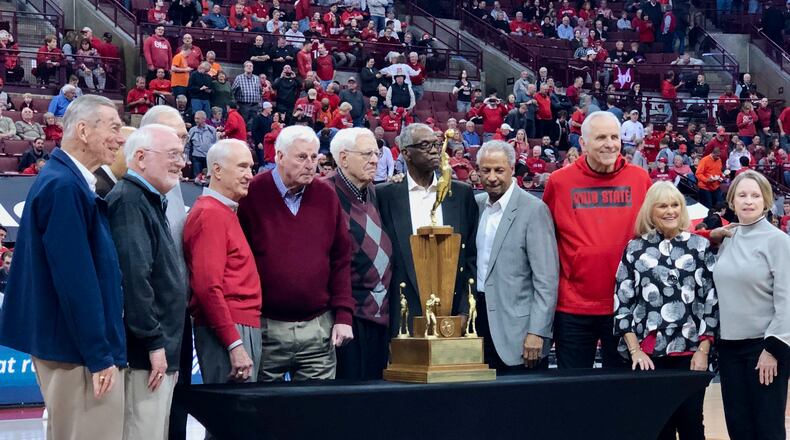Each time, he returned over the last two decades, he showed fans of the Buckeyes love and got it back.
“Any time I come back to Columbus, I feel good about being an Ohio State graduate,” Knight told attendees of the 2012 Ohio State Varsity ‘O’ Athletics Hall of Fame banquet.
“There is nothing in our lives other than our own families that I think we can be prouder of than the fact that we are Buckeyes.”
He was inducted into the OSU Athletics Hall of Fame for overall contributions to the game, which included winning a then-record 902 games as the head coach at Army, Indiana and Texas Tech.
As a player, Knight was a three-year reserve on the Ohio State basketball team.
During that time, the Buckeyes won the 1960 national championship and appeared in three consecutive Final Fours under the tutelage of head coach Fred Taylor. Knight was a teammate of future Hall of Famers John Havlicek, and Jerry Lucas of Middletown.
Knight averaged just 3.8 points and 2.1 rebounds in 74 career games but went on to become one of the most accomplished coaches in college basketball history, winning three national championships, 11 Big Ten titles and being named the conference coach of the year eight times.
He was also a controversial figure for the harsh language he used and the harsh way he sometimes treated players, game officials, reporters and just about anyone else in his orbit it seemed.
Though he was the subject of scorn for much of the time he stalked the sidelines for the Hoosiers, Knight enjoyed a gradual public reconnection with his alma mater in the two decades after Indiana fired him in 2000 for violating a zero-tolerance policy enacted in the wake of allegations he choked a player during practice.
Knight went 37-20 as a head coach against his alma mater, including 36-18 with the Hoosiers, but Knight later admitted feeling some conflict when going against the Buckeyes, especially with Taylor still at the helm until 1976.
“It was really tough for me when I was coaching in the Big Ten and had to go against Coach Taylor,” Knight said during his hall of fame induction speech. “If we won, I didn’t feel good because Coach Taylor’s team lost. When he won, I felt even worse because we lost. It was a no-win situation for me.”
Knight’s return to good graces with Ohio State began with a return trip with one of his Texas Tech teams in 2004 and continued with future appearances, including the hall of fame weekend in 2012 and when the national championship team was honored for its 60th anniversary in 2020.
Credit: DaytonDailyNews
Prior to that, Knight spoke publicly of his affection for Taylor, who passed away in 2002, advocated for OSU football standout Dick LeBeau’s induction into the Pro Football Hall of Fame and publicly defended former football coach Jim Tressel after he became involved in an NCAA scandal that ultimately cost him his job in 2011.
“The football and basketball team scores are the first I look for,” Knight said when his selection for the OSU Hall of Fame was announced. “I enjoyed very much going to school there. I always talk about my background there and the coaches and players I encountered at Ohio State. Whatever I’ve done in my life, this has been more important to me. This pleases me more than anything I’ve ever been a part of. This is something that really means a lot to me.”
About the Author

